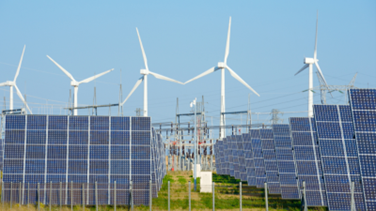Empowering energy-intensive industries: unleashing the power of PPAs
Power purchase agreements: opportunity for Europe’s energy transition
Energy-intensive sectors face the dual challenges of international competition and volatile energy prices. This is problematic for European aluminium primary production where electricity costs can represent up to 40% of total production costs. Direct procurement of green electricity can mitigate both these challenges, as well as help to finance new wind and solar capacity – if the right regulatory framework is in place.
Corporate power purchase agreements (PPAs) are a key part of the energy transition. They are long-term agreements between corporate energy buyers, such as aluminium producers, and energy suppliers. PPAs can provide stability and predictability in energy costs and electricity supply, which are key for energy-intensive industries operating in a volatile global market.
By breaking down barriers to renewable energy sourcing and enhancing the structures that support it, Europe can not only meet its environmental goals but also ensure its manufacturing industries are resilient and competitive so as to deliver the raw materials needed for building up new wind and solar capacity.
Obstacles to electro-intensive industries embracing PPAs
For electro-intensive manufacturing industries like primary aluminium, the main barriers to entering into these long-term contracts are the uncertainties in extra costs of procuring electricity. These include network costs, surcharges for renewable energy support schemes or other non-recoverable taxes. Another example is the indirect costs of the EU Emissions Trading System embedded in wholesale electricity prices. These are reflected in the ‘strike price’ agreed upon when signing RES PPAs. The continued possibility of indirect cost compensation under the ETS State Aid Guidelines beyond 2030 is thus crucial to allow industry to continue to sign PPAs.
Shaping costs are also problematic for electro-intensives. These are costs to match the electricity generated by a wind or solar farm to the demand of the industrial plant. Historically PPAs have been signed by electro-intensive industries in the Nordics where hydropower is cheap and can generate electricity when the wind isn’t blowing and the sun isn’t shining. We do also see PPAs being signed by electro-intensives in Spain, Belgium, and Poland where there is a good supply of renewable energy and strong demand. Elsewhere, PPAs remain challenging because of the shaping and firming costs that result from the need to match variable renewable generation to baseload consumption.
This credit risk is also a reason why more corporates aren’t signing PPAs: PPAs are long-term agreements, and therefore the energy buyer must be able to pay for the electricity for the duration of the, typically, 5-15 year contract. Participation in guarantee schemes to mitigate non-payment risks remains low, and they do not address the key risks faced by electro-intensive consumers when signing PPAs.
Lack of education amongst corporate energy buyers about energy procurement and of capacity to negotiate complex contracts can also be barriers.
Also, electricity market interventions seen over the past years created a difficult investment environment for new renewables projects via long-term agreements like PPAs, which can be up to 20 years in duration.
Grid bottlenecks and inflexible grids, with low levels of battery storage, result in high shaping costs. Saturated grids and delays in grid connections create uncertainty around delivery of green energy certificates which prove the link between the renewable power plant and the energy consumption.
Permitting processes for renewable energy projects are a major hurdle. It’s complex, restrictive, lengthy, and involves too many stakeholders, leading to project development delays and increased costs.
Clearing the path: how regulation can help
Strengthening regulatory stability and fostering an investment-friendly environment will drive further adoption of corporate renewable PPAs – and unlock private financing of new wind and solar power plants. The revision of the Electricity Market Design, Renewable Energy Directive, and the Grids Action Plan have equipped the EU with the right rules and measures to grow the PPA market. Implementation at national level of all three EU initiatives is now key to the transition to a fully decarbonised, resilient, and flexible electricity grid.
Modernising and expanding grid infrastructure is essential but, the cost of grid investments must be allocated in ways that do not create burdens on electro-intensive industrial consumers, who are sensitive to electricity prices.
The reformed electricity market design permits the combination of PPAs and two-way contracts for difference (CfD). This avoids the risk of crowding out PPAs. Whilst state-backed two-way contracts for difference can lead to bigger volumes, there is potential for bringing even more renewables online if we combine PPAs and CfDs. Belgium is a front-runner in the EU in developing a PPA-CfD hybrid project – other Member States must follow suit.
Under the market design reform, financial support schemes, such as guarantee schemes, must also be in place in every EU country. This intends to mitigate the credit risk issue. Some pilot schemes have been designed, with limited success. Learning what works and what doesn’t will be key to help more companies sign PPAs via this route.
As we move towards more and more hybridisation of renewables projects, the combination of solar, wind and storage can optimise the generation profile of PPAs. Designing a regulatory framework for co-located and hybrid renewables is an important evolution, so developers can provide innovative solutions for specific consumption profiles, such as electro-intensives.
GOs are crucial for verifying the source of renewable electricity in PPAs but stricter oversight by both national and European regulators is essential to prevent double counting and uphold the credibility of green electricity claims. Simplifying the GO registration process and cross-border harmonisation would further enhance the system.
Europe’s journey towards a sustainable future is ambitious, with goals set to achieve carbon neutrality by 2050 and increase renewable energy usage to 42.5% by 2030. The EU Member States must implement new rules for renewables at pace. Educating policymakers and industry players about the benefits and mechanics of PPAs and the barriers industrial consumers are facing is essential. The new political term in Brussels after the election is an opportunity for energy producers, industrial consumers, regulators and the financial community to come together to ensure energy production and consumption can thrive in Europe without losing its industrial base.


